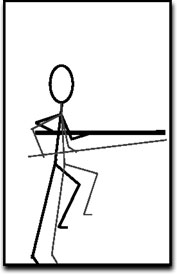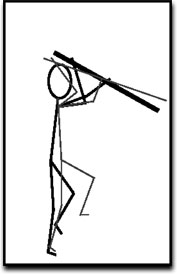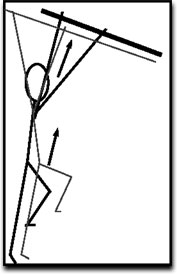|
Pole Vaulting
|
Articles
By: Brian Yokoyama,
Mt.
San Antonio College (Mt. SAC)
|
Sub Titles:
The Takeoff
Narrow Grip Drill
The Pole Vaulting Pole
The Swing
The Flyaway & Bar Clearance
The
Takeoff
The takeoff
(plant) is the most important technical aspect of the pole vault.
It is responsible for transferring running energy(speed) into the
pole and setting up the swing/rockback. As the efficiency of the
plant increases, a greater amount of energy is transferred to the
pole, allowing for the use of stiffer poles and increased clearances.
Previous
biomechanical studies have shown many US Vaulters to be inefficient
in the transfer of running energy into the pole (1991 Tokyo World
Championship Biomechanical Study). Often, coaches have utilized
set up techniques which produce inefficient takeoffs. This causes
vaulters to be consistently under their top hand at takeoff. Adjusting
the running distance (step) will not alleviate this problem. In
order to increase efficiency at takeoff, maximize pole size, swing
ability (rockback) and heights, coaches and athletes should consider
converting to the European/Japanese/Russian plant teaching systems.
These methods
utilize a takeoff placing the pole vaulter at a 90 degree angle,
perpendicular to the pole. An example can be demonstrated by placing
a pole horizontally supported at each end. Bending of the pole is
most efficient when force is applied at a 90 degree angle (perpendicular
to the pole). Any angle greater or less than 90 degrees would result
in lost energy. The pole vault takeoff should emulate this concept
(figure 3). Set up should prepare the vaulter to takeoff at this
angle.
The following
diagrams demonstrate a three phase model of this takeoff (the model
is a right handed vaulter: left foot, right foot, takeoff). The
light colored figures set up techniques resulting in inefficient
energy transfer.
 Left
Support Phase (fig. 1)
Left
Support Phase (fig. 1) |
 Right
Support Phase (fig. 2)
Right
Support Phase (fig. 2) |
 Takeoff
Phase (fig. 3)
Takeoff
Phase (fig. 3) |
A.
Right hand is parallel to the body, not behind it.
B. Both arms are tucked
up high (forces the vaulter to plant forward).
C. Body is in a slightly
forward sprinting (power) position.
D. Pole is at a parallel
position to the ground. |
A.
Both arms are
in front of the head (the arms guide and the body follows behind).
B. Body is in a balanced
position.
C. Left leg is cocked and
ready for an explosive takeoff (penultimate step).
D. Arms are ready to help
jump. |
A.
Arms and body
are creating a 90 degree angle with the pole.
B. Both arms are extended
and equally placing pressure into the pole.
C. Body and foot are fully
extended prior to the pole impacting the back of box. |
Next
Page
International Copyright © of CoachesEducation.com. All Rights Reserved.
Reproduction in whole or in part in any form or medium without
express written permission
of CoachesEducation.com is strictly prohibited.
|
| ![]()




